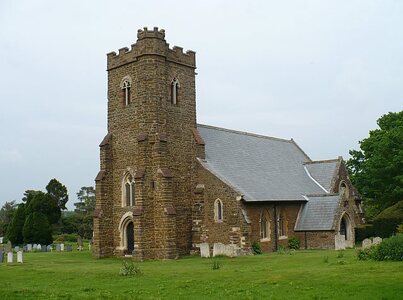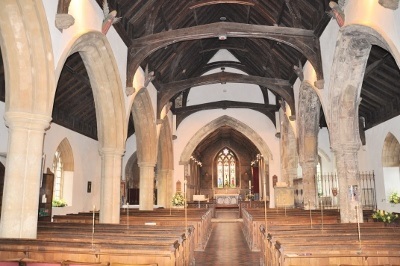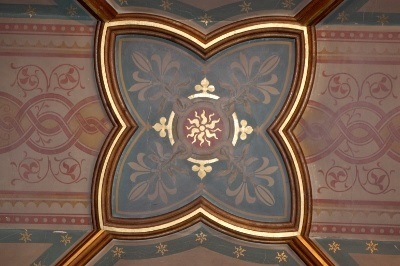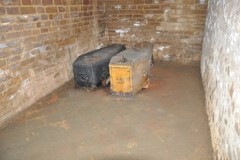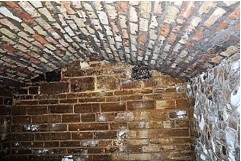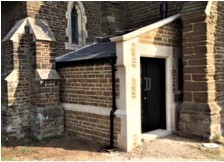|
The Church of Haynes is first mentioned in 1150, when it was given by Pain and Rose deBeauchamp to the priory of Chicksands on the occasion of the foundation of the latter. St Mary’s Church was mostly rebuilt in 1850 through the generosity of Lord John Thynne, who succeeded to the Lordship of the Manor in 1849 and ownership of Haynes park. The mansion is visible across the park to the north of the church. |
||||
|
Of the medieval church there are substantial remains, much masked by later work. The most striking and earliest visible work inside the building is the South Arcade of four bays of quatrefoil piers and double chamfered arches, dating from c.1300 and the Chancel and Tower Arches of c.1350-1400. These indicate that the nave retains its medieval length of 60 feet, and with the exception of the north aisle is substantially of its medieval capacity. That there was an earlier church is confirmed by the fact that the list of clergy goes back to 1150 and it is likely that a new church was built c.1115 by the monks of Chicksands priory who were responsible for the structure and staffing of the building. |
South Arcade |
|||
|
|
||||
|
Chancel |
The Tower, restored during 1986, is of the late 14th century, built mostly of local ferruginous sandstone (carstone) with dressings of chalky Toternhoe stone, visible as grey voussoirs alternating with sandstone over the tower windows, and in the earlier tracery where this survives. The Chancel is structurally of the late 14th or early 15th century but has been altered by later work. The ceiling was remade in the late Georgian period - the thin ribs to the plaster vaulting are typical of such work of the late 18th century, and may coincide with the rebuilding of the south front of Haynes Park in the early 1790s when the necessary craftsmen would have been readily to hand. |
|||
|
The Victorian Rebuilding in 1850, the year after the Reverend Lord John Thyne, Canon and Sub-Dean of Westminster Abbey, inherited the estate (then called Hawnes Place), formed part of the general improvement scheme which included the building of a village school almost opposite the church, improvements to local water supplies, the rebuilding of the rear part of the mansion and improvements to farms and cottages on the estate. Although the church was originally a medieval buidling, it was largely reconstructed in 1850 by the architect, Henry Woodyer of Guildford, Surrey. A summary of the work undertaken was reported in the Bedfordshire Times for the 26th July 1851, which records the service of rededication held in the 'new' church on Thursday 17th July 1851. |
||||
| The North Aisle was added to the church with its new arcade copying the earlier work in the south arcade. A Chantry chapel was built for the future reception of the bodies of Lord John and his wife, Anne Constantia, and a new vestry on the north-east of the sanctuary. The south wall of the church was rebuilt and underpinned as necessary, and the regular carstone masonry on the outside indicates that the entire wall was refaced at this time. New windows in the machine-dressed stone in 14th century style replaced the earlier windows of various dates which were of Toternhoe stone and probably much decayed. The south porch was rebuilt. The Rose Window - Woodyer's 'trademark' - can also be seen on the old school building opposite the church. |
Rose Window |
|||
|
Pulpit |
The Nave received a new roof in oak, of the highest quality, and adorned with carved detail picked out in colour. The present pews were put in at this time, as was the Pulpit of Caen stone from Normandy. In the Chancel the only major structural changes were the demolition of part of the north wall and the construction of a parclose screen between the chancel and Lord John’s new chapel, at the east end of the north aisle, and the insertion of a new East window. The stained glass in the East Window is in typical Victorian brilliant colour by Mr. O’Connor whilst the rest of the glass is by Clayton and Bell. The glazed tiles in ‘medieval’ style which floor the sanctuary were supplied by Messrs. Minton. The organ with its colourful painted pipes was built by Mr. Walker. It was awarded a certificate by the British Institute of Organ Studies and is now listed in the Institute’s register of historic pipe organs as being an instrument of importance to the national heritage and one deserving careful preservation for the benefit of future generations.
|
|||
| The whole Chancel was entirely redecorated with an overall pattern of stencilled motifs which extended into the adjoining Thynne Chapel. Designed by Henry Woodyer and executed by Clayton & Bell, the stencilling, freehand painting and religious texts in subtle colour combinations unify the Victorian and earlier work and the chancel ceiling was adorned with angels and gold stars. The new ironwork and stonework of the parclose was also enriched with colour.
The chancel has on the north wall, near the vestry door, a monument to Sir Anthony Newdigate who died in 1568. A rectangular slab of Purbeck marble is carved in low relief, the design consisting of bands of lead and quatrefoil ornament over an arch of early 16th century form. The figure is composed of four brass (latten) plates and include a kneeling figure at a reading desk, a shield of arms and a crest. Traces of enamel enrichment occur on the shield, crest and figure - red, yellow and brown colours have been noted. |
Organ |
|||
|
Also in the chancel, on the south wall, is a sedilia or stone seat for the clergy, of 1850. The brass candle holders on the choir stalls also from 1850. The Bishop’s Chair was made in 1973 by Robert, son of revd. Eric Quin, the vicar at the time. Queen Victoria is said to have knelt on the celebrated Haynes Cloth of Gold at the time of her coronation in 1837. The cloth was given to the Reverend Lord John Thynne in recognition of his services as chamberlain at the ceremony and he presented it to St Mary’s in later years. It can be seen decorating the altar on important occasions. |
||||
|
Monument to Lady Anne Constantia Thynne |
The Thynne Chapel was redesigned in 1868 by George Gilbert Scott in preparation for the installation of a monument to Lady Anne Constantia Thynne (née Beresford) who died on 22nd April 1866. G. G. Scott was one of the most prolific architects that Great Britain has produced and he designed many iconic buildings including St Pancras station and the Albert Memorial in London. The alabaster effigy of Lady John Thynne was by Henry Hugh Armstead, the renowned sculptor who also worked on the Albert Memorial. The chapel is superbly decorated in the same style as the chancel but with greater cost and elaboration - an outstanding example of Victorian funerary art! The floor of the Thynne Chapel is an extremely impressive marble and tile structure reminiscent of the Cosmati style. It is understood that the floor was undertaken by Messrs. Poole & Sons of Westminster as well as the wrought iron screen.
|
|||
|
Many churches were decorated during this period. Indeed, few escaped the often drastic restoration or replacement of their medieval structures. Most have since lost any polychrome applied during the 19th century - scraped off or whitewashed over in an attempt to return to the supposed medieval state. At Haynes, we have an excellent example of a fast disappearing form of decoration which despite its 160 or so years is still in reasonable condition. This may be attributed to the excellence of the original materials and the skills of the craftsmen who did the work.
|
Floor of Thynne Chapel |
|||
|
The Crypt under Thynne Chapel |
Beneath the Thynne Chapel is a vault or crypt containing the coffins of Lady John and Reverend Lord John Thynne who died on 7th February 1881 aged 82. During repointing of the external stonework in 2013 the crypt under the Thynne Chapel was opened up and found to contain two coffins, one leather bound of Lady Anne and the other lead lined oak cofin of Lord John Thynne. The crypt was remarkably dry and in very good condition. |
|||
|
In the South Aisle, adjacent to the south door, is the Font, octagonal in form, of plain detail of circa 1400. At the east end of the aisle is the vault which contains the remains of the Carteret family, Lords of the manor and resident at Haynes Park from the 17th century until 1849 when Lord John inherited the estate from his uncle. Many interesting mural monuments overlook the fine Victorian wrought iron screen which encloses a pavement of Minton tiles. A central slab of black marble is inlaid with a cross of enamelled brass, decorated with designs which include the symbols of the four evangelists.
|
Font |
|||
| The Tower which was not included in the rebuilding work of 1850 was considerably restored in 1986. The embattlements were rebuilt, a new lead roof was installed and the whole tower was repointed. It contains six bells:
The fifth bell bears the inscription ‘MATRIS MESSIE PIE SUM CAMPANA MARIE’ which, although not good Latin, probably means something like ‘I am the bell of Mary devout mother of the Messiah’. A date c. 1350 or soon after would seem to equate with the earliest date possible that a major rebuilding and rededication took place. The canons of Dunstable Priory record that the townspeople paid for a new bell in 1349 to be used as a Sanctus bell and “They called the bell Mary”. It is quite possible that the parishioners of Haynes did the same thing. The Dunstable bell also survives, and can be seen in the Priory Church. PATRONAGE As previously stated records survive since 1150, when Haynes Church was given by Pain de Beauchamp, baron of Bedford, and his wife Rose, to the monks of Chicksands Priory. Pain was Lord of the Manor of Haynes, and lived in Bedford castle. The church remained the property of Chicksands Priory until the dissolution of the monastery in 1539. The Prior of Chicksands had to provide the parish priest, and give him a house and garden as well as paying all charges for the church including its upkeep. In return the priest paid the priory fifteen shillings a year out of his income from tithes and other sources. In 1235 the total value of the church was assessed at £8 and this was still the amount mentioned in the valuation of 1535, so the value remained the same for over 300 years! After the dissolution, the patronage, or right to appoint the vicar, was granted by Henry VIII to William Arden, who seems already to have had a financial interest in Haynes Church since the early 1530’s. He was a friend and supporter to the vicar, Mr Franklin, who was in dispute with the diocesan authorities over irregularities which allegedly came to light during the Visitation and valuation of the church in 1535. In 1544, Henry Audley and John Maynard were granted the tithes and vicarage, but by 1587 they had passed to Edward Snowe, a Londoner who had purchased Chicksands Priory from the Crown and in turn sold the estate to Peter Osborn and his heirs in 1587. The Advowson of the vicarage has remained in the Osborn family since that date, until, on the death of Sir Danvers Osborn in 1984, his heir gave up the patronage, now vested in the Bishop. The Osborn family has had a colourful and interesting history, from their arrival in the area in 1587 until the transfer of the Chicksands estate to the War Office in 1936. For the last century, or so, they were not resident continuously, and the house of Chicksands was sometimes let. Although the bulk of the restoration work at St Mary’s in 1850 was undertaken by Reverend Lord John Thynne of Haynes Park, Lady Osborn and her daughter represented the Patron at the service of rededication. Also present were Mr & Mrs Bainbridge who rented Chicksands from the Osborns at that time. Until the recent death of Sir Danvers Osborn, the last Patron, the family maintained close contact with St Mary’s, even since the passing of the Chicksands estate to military use in 1936. A list of past vicars is displayed within the church. Many of these were lively characters in whose behaviour the religious turmoil of the 17th and 18th centuries is typically portrayed, although perhaps the wise choice of successive patrons helped to avoid the extremes of religious activity sometimes evident in the Eastern counties. James I and his queen, Anne of Denmark, who visited the neighbouring estate of Chicksands, and Haynes, attended Divine Service in St Mary’s on 30th July 1605, attended by the whole court! The kitchen and toilet facilities were designed by Bruce Deacon the current church architect, and completed during 2001, thus providing facilities in keeping with the 21st century. |
||||
|
Grills in East Wall and variation in stonework |
It is worth noting that the South Wall is of random stonework whilst the other walls are dressed and coursed also there are two grills at high level on the East wall whose purpose is unknown. The Vestry is on the East side of the wall at ground level.
|
The New Boiler House |
||
|
In 2016 the unsightly external boiler house was demolished due to damp penetration of the North wall of the tower and a new sympathetic stone building was constructed to house the boiler and churchyard maintenance equipment. During excavation for the foundations a double arched brick crypt was discoverd housing two coffins. This crypt, partially beneath the foundations of the North aisle, pre-dates 1850 and is possibly of mediaeval origin.
|
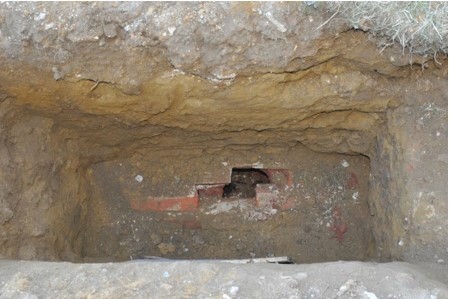 Double Arched Brick Crypt with two Coffins Double Arched Brick Crypt with two Coffins |
|||
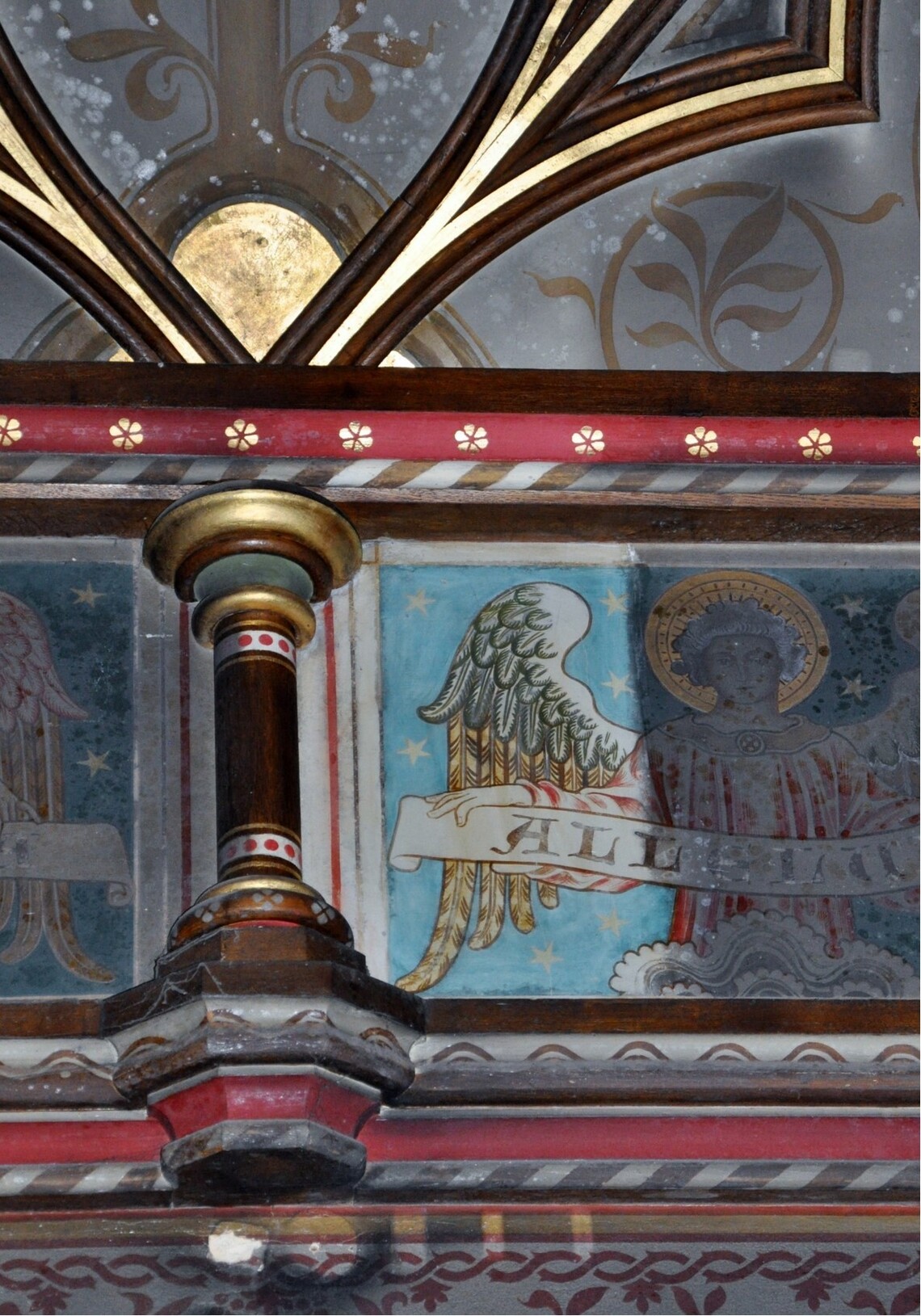 |
If you would like to see our rare and beautiful decorations restored to their former glory perhaps you would like to make a donation toward the cost of the works estimated to be about £250,000 in 2017. All donations would be most gratefully received and can be left in the box in church.
|
|||
| If you would like a printed copy of this Brief History of St Mary's Church Haynes, a booklet can be purchased from the church or by contacting one of our Church Wardens at the cost of £1.00. | ||||
Skip to main content
